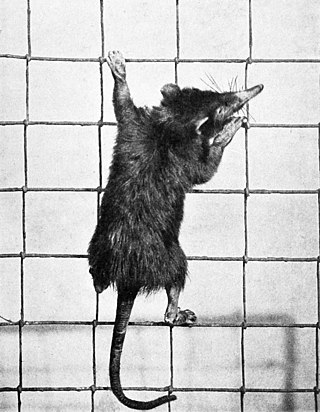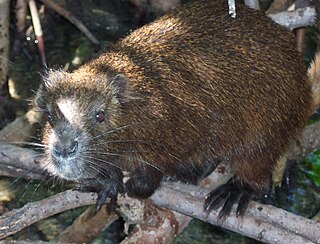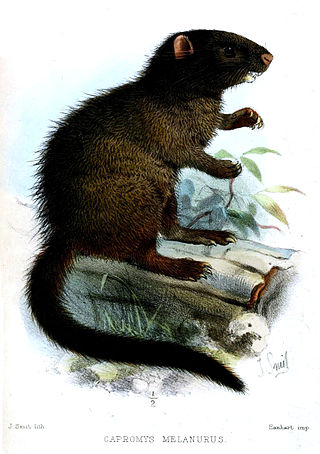
The Cuban solenodon or almiquí is a small, furry, shrew-like mammal endemic to mountainous forests on Cuba. It is the only species in the genus Atopogale. An elusive animal, it lives in burrows and is only active at night when it uses its unusual toxic saliva to feed on insects. The solenodons, native to the Caribbean, are one of only a few mammals that are venomous.

Solenodons are venomous, nocturnal, burrowing, insectivorous mammals belonging to the family Solenodontidae. The two living solenodon species are the Cuban solenodon and the Hispaniolan solenodon. Threats to both species include habitat destruction and predation by non-native cats, dogs, and mongooses, introduced by humans to the solenodons' home islands to control snakes and rodents.

Pico Duarte is the highest peak in the Dominican Republic, on the island of Hispaniola and in all the Caribbean. At 3,101 m (10,174 ft) above sea level, it gives Hispaniola the 16th-highest maximum elevation of any island in the world. Additionally, it is only 85 kilometres northeast of the region's lowest point, Lake Enriquillo, 46 m below sea level. It is part of the Cordillera Central range, which extends from the plains between San Cristóbal and Baní to the northwestern peninsula of Haiti, where it is known as the Massif du Nord. The highest elevations of the Cordillera Central are found in the Pico Duarte and Valle Nuevo massifs.

Nesophontes, sometimes called West Indies shrews, is the sole genus of the extinct, monotypic mammal family Nesophontidae in the order Eulipotyphla. These animals were small insectivores, about 5 to 15 cm long, with a long slender snout and head and a long tail. They were endemic to the Greater Antilles, in Cuba, Hispaniola, Puerto Rico, the United States Virgin Islands, and the Cayman Islands.

The Hispaniolan solenodon, also known as the agouta, is a small, furry, shrew-like mammal endemic to the Caribbean island of Hispaniola. Like other solenodons, it is a venomous, insect-eating animal that lives in burrows and is active at night. It is an elusive animal and was only first described in 1833; its numbers are stable in protected forests but it remains the focus of conservation efforts.

The Hispaniolan hutia is a small, endangered, rat-like mammal endemic to forests on the Caribbean island of Hispaniola. It lives in burrows or trees, and is active at night when it feeds on roots and fruits. A member of the hutia subfamily (Capromyinae), it is endangered from habitat loss and introduced species, such as rats or mongoose.

Desmarest's hutia or the Cuban hutia is a stout, furry, rat-like mammal found only on Cuba and nearby islands. Growing to about 60 cm (2 ft), it normally lives in pairs and feeds on leaves, fruit, bark and sometimes small animals. It is the largest living hutia, a group of rodents native to the Caribbean that are mostly endangered or extinct. Desmarest's hutia remains widespread throughout its range, though one subspecies native to the nearby Cayman Islands went extinct shortly after European colonization in the 1500s.

The Galápagos rice rat, also known as the Galápagos oryzomys, is a species of rodent that is endemic to the Galápagos Islands.
The false canyon mouse or Coronados deer mouse, is a species of rodent in the family Cricetidae. It is known only from Coronados Island, a small island in the Gulf of California, part of Baja California Sur, Mexico. The species is threatened by predation by feral cats, and the IUCN has assessed its conservation status as "critically endangered".
The Hispaniolan edible rat is a recently extinct species of rodent in the family Echimyidae. It is the only species in the genus Brotomys. It was endemic to the island of Hispaniola in the Caribbean, in what is today the Dominican Republic and Haiti. Its natural habitat was subtropical or tropical moist lowland forests.

The black-tailed hutia, also known as the bushy-tailed hutia, is a small, furry, rat-like mammal found only in Cuba. It lives in lowland moist forests and is threatened by habitat loss. It is a member of the hutia subfamily (Capromyinae), a group of rodents native to the Caribbean that are mostly endangered or extinct.
The St. Michel nesophontes is an extinct species of mammal in the family Nesophontidae. It was endemic to Hispaniola.

Thomas's fruit-eating bat, sometimes also popularly called Watson's fruit-eating bat, is a species of bat in the family Phyllostomidae. It is found from southern Mexico, through Central America to Colombia. Its South American range is to the west of the Andes. The species name is in honor of H. J. Watson, a plantation owner in western Panama who used to send specimens to the British Natural History Museum, where Oldfield Thomas would often describe them.
A unique and diverse albeit phylogenetically restricted mammal fauna is known from the Caribbean region. The region—specifically, all islands in the Caribbean Sea and the Bahamas, Turks and Caicos Islands, and Barbados, which are not in the Caribbean Sea but biogeographically belong to the same Caribbean bioregion—has been home to several families found nowhere else, but much of this diversity is now extinct.

Panolopus marcanoi, commonly known as Marcano's galliwasp or Pico Duarte galliwasp, is a species of lizard in the family Diploglossidae. It is endemic to the Dominican Republic.

Solenodon is a genus of small, shrew-like mammals native to the Caribbean. It is one of two genera in the solenodon family, Solenodontidae. The genus Solenodon includes three species, only one of which is still living—the Hispaniolan solenodon. This classification follows the American Society of Mammalogists.










